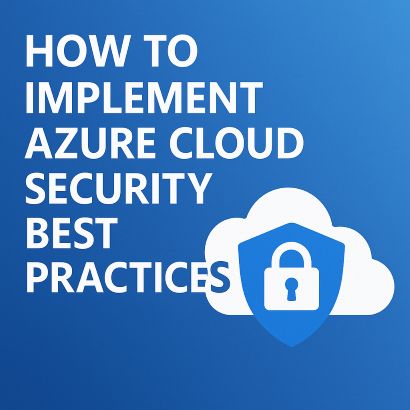Table of Contents
Introduction

In today’s digital-first landscape, organizations are increasingly leveraging cloud platforms like Microsoft Azure to accelerate innovation, enhance scalability, and reduce operational costs. However, as cloud adoption rises, so does the need for a strong cloud security foundation. Securing your Azure environment isn’t just a best practice—it’s a mission-critical requirement.
Cyber threats are becoming more sophisticated and relentless. Microsoft’s 2024 Digital Defense Report highlights that over 4,000 password attacks occur every second, with a sharp increase in nation-state and ransomware threats specifically targeting cloud infrastructures. Without robust cloud security measures, your data, applications, and workloads in Azure remain exposed to significant risk.
This comprehensive guide provides actionable, step-by-step best practices to build a secure, resilient, and compliant Azure environment. Whether you’re a security architect, IT administrator, or business leader, you’ll discover how to:
- Strengthen Identity and Access Management (IAM)
- Secure Azure Virtual Machines and networking
- Protect databases and cloud application services
- Enable advanced threat detection and response using Microsoft Defender for Cloud
- Enforce governance and regulatory compliance with native Azure security tools
By adopting a Zero Trust model and leveraging Microsoft’s advanced cloud security ecosystem, you can safeguard your digital assets and stay ahead of evolving threats.
Why Azure Cloud Security Matters
With over 90% of organizations leveraging cloud services, attackers are focusing their efforts on cloud and hybrid environments. Microsoft reports a 130% year-over-year increase in ransomware, with over 80% of attacks starting from compromised credentials.
Establishing a comprehensive Azure security architecture ensures you meet regulatory requirements, protect sensitive data, and maintain business continuity in the face of growing cyber risks.
Sample Enterprise Scenario
FinBank Corp, a mid-sized financial services company with 1,500 employees, is transitioning from an on-premises setup to Azure. Their goals include enhanced scalability, cost-efficiency, and support for remote work via a Bring Your Own Device (BYOD) policy.
Let’s explore how they can design a robust cloud security architecture in Azure.
Step-by-Step Azure Cloud Security Solution
1. Identity and Access Management (IAM)
Tools: Azure AD (Entra ID), Conditional Access, MFA
- Enable Azure AD Premium P2 for identity protection and risk-based policies
- Enforce Multi-Factor Authentication (MFA)
- Use Privileged Identity Management (PIM) for JIT admin access
- Apply Conditional Access to block risky sign-ins and enforce device compliance
✅ Goal: Reduce identity-based attack surfaces.
2. Azure Virtual Machines (VM) Security
Tools: Microsoft Defender for Cloud, Just-in-Time VM Access, Azure Bastion
- Enable Defender for Servers
- Limit RDP/SSH exposure with Just-in-Time access
- Use Azure Bastion for secure remote access without public IPs
- Perform regular endpoint protection and vulnerability scans
✅ Goal: Harden VMs and prevent lateral movement.
3. Database Security (Azure SQL)
Tools: TDE, Defender for SQL, Azure Key Vault
- Encrypt data-at-rest with Transparent Data Encryption
- Monitor anomalies using Defender for SQL
- Securely store keys in Azure Key Vault
- Enable auditing and threat detection
✅ Goal: Safeguard sensitive data and ensure compliance.
4. Web & Application Security
Tools: Azure App Service, WAF, Defender for App Services
- Use WAF to block OWASP Top 10 threats
- Monitor apps with Defender for App Services
- Use Azure Monitor and Application Insights for observability
✅ Goal: Shield applications from DDoS and injection attacks.
5. Secure Remote Access
Tools: Azure VPN Gateway, Conditional Access, Intune
- Configure VPNs with strong encryption
- Enforce device compliance using Intune
- Restrict access from non-compliant/unmanaged devices
✅ Goal: Secure hybrid work and BYOD policies.
6. BYOD & Device Compliance
Tools: Intune, Compliance Policies, Defender for Endpoint
- Onboard and enforce policies for all accessing devices
- Monitor device health with Defender for Endpoint
- Block access from jailbroken/rooted or non-compliant devices
✅ Goal: Permit only secure devices to access corporate resources.
7. Logging, Monitoring & Incident Response
Tools: Microsoft Sentinel, Defender for Cloud, Azure Monitor
- Aggregate logs into Microsoft Sentinel
- Create custom alerts for suspicious activities
- Automate incident response with Logic Apps
✅ Goal: Real-time threat detection and response readiness.
8. Compliance & Data Protection
Tools: Microsoft Purview, Azure Information Protection
- Apply sensitivity labels and DLP policies
- Monitor compliance with Microsoft Compliance Manager
- Enforce Azure Policy for encryption and configuration standards
✅ Goal: Maintain GDPR, HIPAA, and industry compliance.
Pro Tips
- Use Microsoft Security Copilot to accelerate threat investigations
- Regularly improve your Secure Score in Azure Security Center
- Automate security governance with Azure Policy and Blueprints
Final Thoughts: Building a Resilient Cloud Security Foundation
As cloud adoption grows, so does the attack surface. But with the right strategy, tools, and mindset, you can turn Azure into a fortified, intelligent environment that proactively detects threats, enforces compliance, and supports business agility.
By following these best practices, organizations like FinBank Corp can confidently migrate to the cloud knowing their data, users, and infrastructure are protected with enterprise-grade security. Whether you’re just beginning your Azure journey or optimizing an existing deployment, now is the time to embrace security by design and empower your teams with a secure cloud-first future.
Ready to take action?
Evaluate your current Azure security posture using Microsoft Secure Score and start implementing the practices outlined above. The cloud is your launchpad—make sure it’s built on a secure foundation.
Stay tuned for more insights in our 30 Days of Azure Security series!

